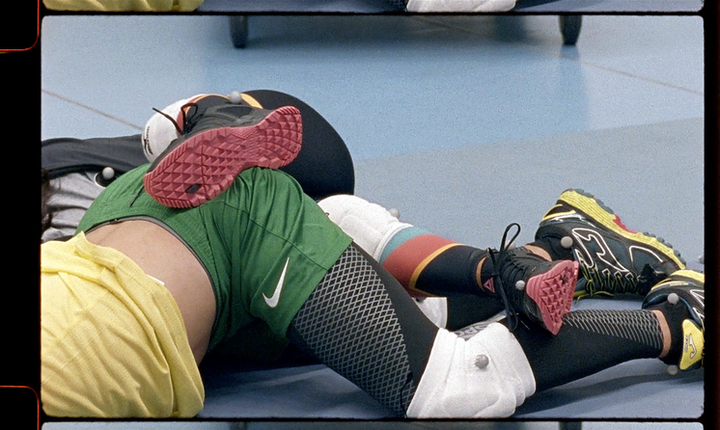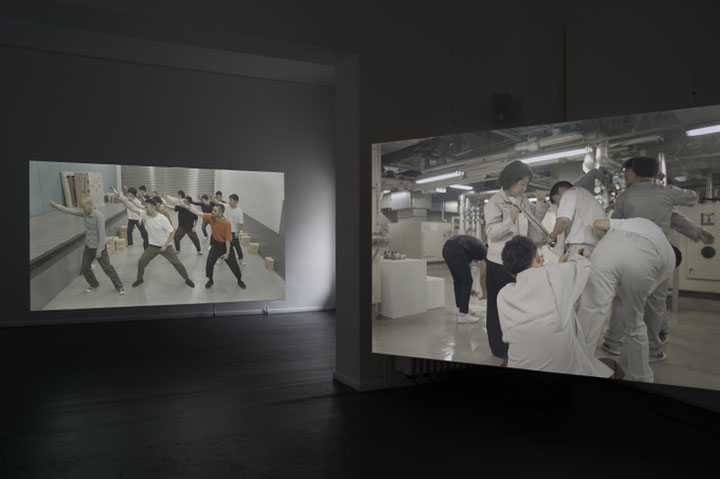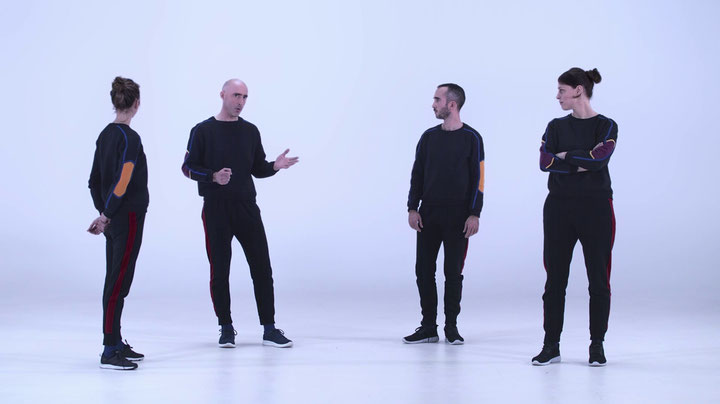Wendy Hui Kyong Chun warns against ascribing too much power to technological control systems by perceiving them to be more effective and pervasive than they are. Chun adopts a stance somewhere between utopian and dystopian positions, both of which assume an all-powerful technosphere. She insists instead on the possibility of “failure and [the] actual workings of technology”.1 A comparable standpoint emerges in recent performative video works that focus on human behaviour in relation to robotics, avatars or machine learning. It is striking that this engagement involves deploying the human body and turns the spotlight on imitating machines.
Today we witness the ways in which machines purportedly become more and more akin to humans as a result of AI, while at the same time humans are supposed to function as if they were machines. Anna Witt’s three-channel video installation Unboxing the Future (2019) comes into play at the threshold of these blurred distinctions. The film refers to automation in Toyota factories in Japan, where 50 percent of the work is done by robots. Three projection screens show a number of workers in a car factory performing repetitive, mechanical tasks. The distinction between work done by humans or by machines becomes indistinct in this performative presentation. As cogs in the gears of specialised, monofunctional work, the workers must adapt to the machines. There is also something meditative about the simple, highly concentrated movements, embedded in the delicate sounds produced by the koto.
Over and above performing a mechanical ballet, the factory workers and developers also address their experiences, hopes and fears about increasing automation. The discussion alternates between negative and positive considerations. Their skills still remain irreplaceable. Witt’s film illustrates fears that this could change: dancers are gradually replaced by detailed shots of fully automated production steps. The group subsequently reflects on a society without work and the performance continues in a different vein. In this phase, specific steps in the work process are rehearsed together until a synchronised performance is achieved. The ensuing choreography turns rational individual activities into a self-organised group activity more reminiscent of Tai Chi than of assembly-line work. Fully self-determined creativity is unleashed at the end of the film. As if in an act of liberation, the workers play an informal jam session and cut off each other’s work clothes.
While the conversation in Unboxing the Future highlights characteristic traits of human beings – the eye and the fingers – that display a complexity that machines cannot (yet) copy fully, the focus in Euphoria Physics (2020) by Andreas Bunte and Stefan Panhans is almost the opposite. It is not humans who serve as role models here, but rather video game avatars and their ability to simulate falls. The film was shot in a motion-capture lab at the University of Münster. In what appears to be a scientific experiment, a man and a woman perform a variety of moves. They flounder around on sports mats, trying to hit the ground in completely twisted stances, attempting to bump into each other almost imperceptibly and yet still fall over or land as softly on each other as if they were rag dolls.
Rather than indicating some kind of incapacity, the emphatic artificiality that permeates the movement studies instead highlights attempts to acquire a skill. The choreographies are based on avatars’ movement patterns, which are calculated in real time in more recent computer games. Euphoria Physics, the title of the film and the term for the technology used in the avatars, is based on a sophisticated process based on bio-mechanical AI rather than animation. It becomes clear that the performers are rehearsing avatar fall patterns, if that was not already apparent, when the dancer, gun in hand, tries to slip without tipping backwards. The situation evokes a scene from the computer game Grand Theft Auto V that is shown in the film’s opening credits, in which the character, stumbling backwards, does not fall but glides across the floor as if weightless. Euphoria Physics inverts the “Uncanny Valley” phenomenon. Rather than viewing the difference between humans and avatars as a lack of algorithmic replication, it is ironically the human body that seems deficient compared to its digital emulation, unable to repeat its calculated choreographies because it is subject to gravity. This human shortcoming could be understood figuratively as a critique of the increasing influence of technology and the growing optimisation of human behaviour. The aesthetics of human falling resist algorithmic appropriation. Instead of achieving the predetermined optimum, the beauty of human “inadequacy” emerges, i.e. idiosyncrasy.
Julien Prévieux’s video performance Where Is My (Deep) Mind? (2019) translates principles of machine learning into human actions carried out by four performers. The idea that humans could in a sense physically become or mimic computer programmes has a prominent precursor in the history of computing: Logic Theorist, often referred to as the first artificial intelligence program. Invented in 1956, the thinking machine was able to prove theorems from Alfred North Whitehead and Bertrand Russell’s Principia Mathematica. The first pre-implementation version was a “hand simulation”, described as “imitating a computer programme”.2 Herbert Simon’s wife and three children took part in the simulation along with graduate students; they each received an index card with the rules concerning the programme components, thus simulating how Logic Theorist behaves using a computer made of human components.3 This curious choreography of humans playing a computer as if this were a board game or a performance has since given way to social media platforms with user-generated content that unwittingly creates data to train machine-learning applications.
Similarly, Prévieux includes passages in which learning processes are acted out by virtual assistants. For example, absurd negotiations on swapping balls, books or hats are performed, sounding like slapstick sketches but derived from dialogue-oriented experimental set-ups from Facebook’s AI research lab in 2017. Words replete with codified meanings give rise to unexpected mistakes and behaviour with a humorous twist when transposed to machines that lack awareness of cultural contexts. However, an off-screen commentary also points out that algorithms use deceptive manoeuvres without being programmed to do that. So where does all this lead? Prévieux’s performances revolve around the increasing entanglement of humans and machines, while nonetheless seeking to uphold their differences. Focussing on the machine’s imperfections and inverting the role of AI ad absurdum breaks ironically with notions of technological singularity, prioritising human intelligence. A commentary at the end of the film also warns, however, that human work, which currently still compensates for the machine’s imperfection, heralds its own redundancy by constantly improving that technology.
Translated by Helen Ferguson
[1] Wendy Hui Kyong Chun, Control and Freedom: Power and Paranoia in the Age of Fiber Optics. Cambridge, Mass.: MIT Press, 2006, p. 9.
[2] Herbert A. Simon, Models of My Life. Cambridge, Mass.: MIT Press, 1996, p. 205.
[3] See ibid. , pp. 206–207.


